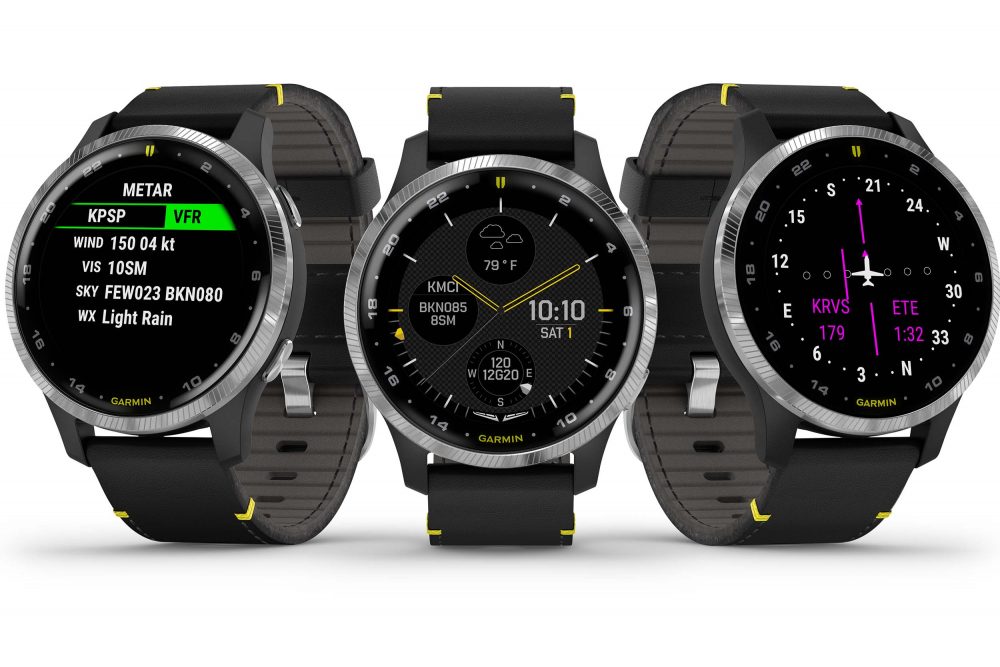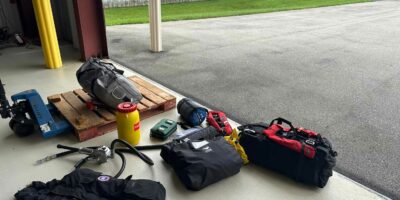Previously, Garmin’s pilot watches could be defined by three distinct features. The look was big, chunky and heavy, the menu system and buttons took a little bit of getting used to, and they had punchy prices with the top of the range D2 Delta PX Aviator costing nearly £1,200. They’re great watches, but Garmin has clearly figured out that there’s a market for pilots who want the latest technology in a slimmer, lighter form factor, and at a lower price. Enter the Garmin D2 Air Aviator Smartwatch which sells for £474.
Before taking a closer look at the watch and how it works inflight and on the ground, it’s worth asking why you’d want a pilot watch in first place? Pretty much everyone flies with a telephone or tablet of some kind, and even the most basic of installed or portable GPS units will give you all of the functions you’re likely to want. Truth is, that most of us like watches, it’s a part fashion, part utility kind of thing. Having a bunch of functions and benefits right there and easily accessible on your wrist is why you’d choose a fully featured pilot watch over the simplest and cheapest digital timepiece you can find.
What’s important and what’s good to have in a pilot watch? Under the ‘important’ list, I’m going for the ability to tell the time (err, obviously), and an easy way to see UTC (we’re lucky in the UK, but flying overseas and continually figuring out the offset between local and UTC is a bit of a pain if you’re not tuned in to the time zone), and some people absolutely insist that you need a watch with a stopwatch function too. I am not one of those people, but it can’t hurt. If you fly at altitude with or without oxygen, having a pulse oximeter on your wrist is both good and important, although more on that later.
Under the ‘good to have’ banner, for me would be a GPS and navigation function. It’s not that I would ever plan to navigate solely by the electronic watch on my wrist, but come on, why wouldn’t you want that back-up if your existing four or five GPS units walked off the job? On a more serious note, it’s sometimes useful to be able to use your watch to check out a ‘what if’ plan B, while leaving your other kit to take care of plan A, and if you really do need something quick and easy after everything else goes AWOL, then DCT (Direct To) nearest is a result.
Speaking personally, I also want any pilot watch to automatically (based on something like ground speed or climb rate) log my flights so that I have the data in electronic form either for later synching to my electronic logbook, or copying to paper (I know, I’m a bit old school like that). Having an airfield database is good, as is the ability to check weather at a glance (the D2 Air needs to be paired to the a phone for that to work).
The D2 Air does all this and a lot more, so what’s it actually like and how does it work in practice? I mentioned earlier that it’s both smaller and lighter that previous Garmin pilot watches. That said, the watch face itself is actually larger, the bright AMOLED touch screen has a 39mm diameter with Gorilla Glass to keep it tough. The watch itself is significantly slimmer and much much lighter, and is supplied with both a leather and silicone strap. Garmin claims the battery is good for five days of normal use, or 10 hours in the air if the GPS, heart rate and pulse oximeter sensors are on. Honestly, I have never worn it for five straight days without taking use of one or other of the sensors, and I imagine most owners will charge it every couple of days, if not every day.
Sensor tech
Talking of sensors, the D2 Air has a wrist-based pulse oximeter built-in, and perhaps better still it is possible to set an alarm that will warn you of low O2 levels. While nobody, including Garmin would suggest that you rely entirely on the D2 Air for that critical data, where hypoxia and its creeping disabling effects are concerned, having an extra sensor and an associated alarm has to be a win – and may I poke my head into your personal flying here, and suggest that if you get a low O2 alarm on your watch (or any other O2 sensor) that you follow a pre-determined response; low oxygen and figuring out what to do in real-time is not a winning combination.
Although there are two buttons, the functions are set and controlled through the touch screen.
Obviously I avoided any instructions, partly because that’s what I (almost) always do, and partly because most of the functions on a touchscreen smartwatch shouldn’t need any, and they don’t. But I am happy to put my hands up here and admit that I’m plain wrong. If you buy this watch, play around, change the settings, change the configurations, but then go and read the manual to find out about the features you didn’t even know about!
If you have Garmin’s Connext connectivity in your aeroplane then you can send an active flight plan to your watch, but you can’t send it back the other way. Honestly, between my iPad, telephone and multiple GPS screens I don’t find myself looking at my watch for navigation cues (there’s no moving map but there’s a pseudo HSI screen), but I did simulate a ‘loss of everything but my watch’ situation, and it only takes one button push and a couple of screen prods to set you on your way to your nearest airport (or any other of your choosing).
Finally, the D2 Air shares very close ancestry with the Garmin Venu sports watch, so there’s loads of extra functionality built-in should you be a runner, walker, cyclist etc. as well as the other functions that you’d expect from a smartwatch paired with your phone such as notifications, music, electronic payment etc.
So what’s the verdict? If you’re in the market for a smartwatch that has aviation specific functions then the D2 Air provides them in a versatile package that’s significantly smaller, lighter and lower cost than previous Garmin watches, plus it’s loaded with all sorts of other sports and smartwatch functions for those times when you’re not flying.







